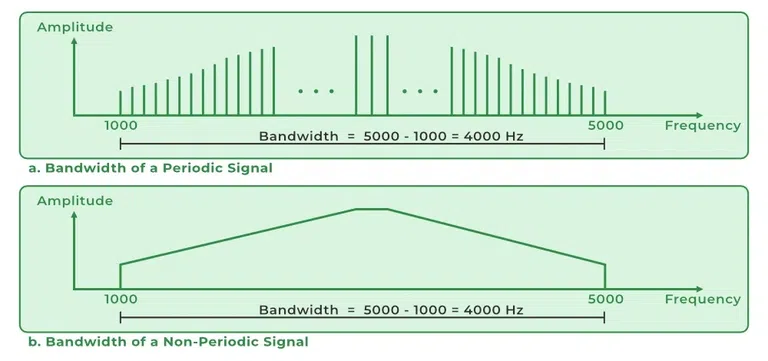
Last Updated : 13 May, 2023
Bandwidth, or precisely network bandwidth, is the maximum rate at which data transfer occurs across any particular path of the network. Bandwidth is basically a measure of the amount of data that can be sent and received at any instance of time. That simply means that the higher the bandwidth of a network, the larger the amount of data the network can be sending to and from across its path. Be careful not to confuse bandwidth with closely related terms such as the data rate and the throughput. Bandwidth is something that deals with the measurement of capacity and not the speed of data transfer.
Units of Measurement
Bandwidth is usually measured in bits transferred per second through a path or link. The common units of bandwidth we come across are as follows.
bps (Bits per second) Mbps (Megabits per second) Gbps (Gigabits per second)
Example: Here, a bandwidth of 10 bps for a channel, is just another way of saying that a maximum of 10 bits can be transferred using that link for any given time. It has no relation with the transfer speed of the channel.
Physical Layer Property in OSI Model
The physical Layer in the OSI Model as we know comes as the bottom-most layer in the Open System Interconnection (OSI) Reference Model. And since this layer deals with communication of the raw data streams across a physical transmission medium bandwidth is an essential parameter of the layer.
Theoretical Nature of Bandwidth
If we closely understand the concept of bandwidth and the information we get from the bandwidth measurement of a network link we can clearly see that it is more of a theoretical (or not real-time value) concept in terms of communication taking place across the network. It is the maximum capacity possible that might not be achieved during most instances of communication. Bandwidth does not depend on the sender and receiver components and is solely determined by the communication media employed to carry the information. Hence, bandwidth is never affected by any physical obstruction as it is a theoretical measurement parameter in a way.
Importance of Bandwidth
It is the bandwidth of a web page that determines how quickly it will load in a browser. When choosing a web hosting platform, this is arguably the most important factor to consider. It is important to consider how the website and internet connection will impact bandwidth. The bandwidth requirement for a website with a lot of graphics can reach 10 gigabytes or more. The bandwidth usage of a simpler website will also be lower. A faster internet connection will allow you to download web pages and movies smoothly, just as a higher bandwidth will improve the user experience.

Bandwidth
Difference between Bandwidth and Speed
Bandwidth and Speed can be differentiated on the basis that Bandwidth tells the quantity whereas Speed tells the fastness of the information. Bandwidth is the quantity whereas Speed is the fastness, how early the information is receiving its destination.
For more, refer to Difference Between Bandwidth and Speed.
Difference between Bandwidth and Latency
Latency can be easily defined as How late the information is coming to the user and Bandwidth is simply the data coming to the user. This is the main characteristic difference between Bandwidth and Latency. An example of latency that we suffer almost every day is Buffering and Bandwidth can be referred to as simply the amount of data received.
Difference between Bandwidth and Throughput
Throughput is simply the data that is finally reaching the destination or in simple words, the product data and Bandwidth is the data coming to the user. This is the main difference between Bandwidth and Throughput. There are some factors that impact the Throughput is that Network Speed, Packet Loss, etc.
For more, refer to the Difference Between Bandwidth and Throughput.
How Much Bandwidth Required For Me?
The amount of bandwidth is totally dependent on your usage. if multiple persons are connecting using multiple devices, in that case, you require a large bandwidth to keep everything working fine. Some common applications like Video Streaming, Gaming, etc. require greater connectivity of bandwidth so that these applications should not lag while running. Simply, it totally depends on the user, and how much bandwidth is required by a user according to its uses.
What is My Computer’s Bandwidth?
The bandwidth required by any user depends on the usage of that person, if he/she requires more bandwidth then that person requires more bandwidth. For example, if someone is regularly using gaming, and streaming HD Videos, it requires a speed of around 100 Mbps maximum for surfing without lag, and for normal use like music, and web surfing. etc. 25 Mbps is the maximum. Sometimes it depends on the person, if the person is patient with buffering, then he/she requires less bandwidth for its usage.
Optimizing Network Bandwidth
Often we are concerned about network speed optimization but optimization of bandwidth is also a matter of importance when it comes to making the network suitable for fast and effective communication. This is because having poorly-optimized bandwidth in a network can surely have an adverse impact on the overall performance of the network and thus decline the efficiency and user experience severely.
Methods of Optimizing Bandwidth
Here are a few methods used to optimize the bandwidth of a given network.
- Using the QoS Settings to set the network traffic policies and prioritize traffic based on its type such that high-maintenance applications are well equipped with the bandwidth needed by them to perform effectively.
- Deploying application public and private clouds that will offload the network as lesser maintenance of the traffic needs to be done in the particular network being optimized.
- Eliminating any kind of unproductive non-essential traffic wastes bandwidth on irrelevant operations.
- Scheduling Updates, installing software patches, or creating backups outside of Peak Hours can significantly reduce the strain on network bandwidth.


Improve
Similar Reads
-
Introduction to Bandwidth
Bandwidth, or precisely network bandwidth, is the maximum rate at which data transfer occurs across any particular path of the network. Bandwidth is basically a measure of the amount of data that can be sent and received at any instance of time. That simply means that the higher the bandwidth of a n
5 min read
-
Introduction to Internet
Computers and their structures are tough to approach, and it is made even extra tough while you want to recognize phrases associated with the difficulty this is already utilized in regular English, Network, and the net will appear to be absolutely wonderful from one some other, however, they may see
10 min read
-
Introduction of Gateways
A gateway is a network connectivity device that connects two different configuration networks. Gateways are also known as protocol converters, because they play an important role in converting protocols supported by traffic on different networks. As a result, it allows smooth communication between t
5 min read
-
Introduction to Digital Communication
With the development of electronics engineering, a need was felt to introduce a system that would help in the transfer of analog signals efficiently by converting them to digital form. This domain of electronics engineering is known as digital communication. In this article, we will study what Digit
9 min read
-
Introduction of Internetworking
Internetworking is combined of 2 words, inter and networking which implies an association between totally different nodes or segments. This connection area unit is established through intercessor devices akin to routers or gateway. The first term for associate degree internetwork was catenet. This i
8 min read
-
Introduction of Gigabit Ethernet
The committee began working on a faster Ethernet, quickly dubbed gigabit Ethernet. The goal was to increase performance while maintaining all Ethernet standards. Gigabit Ethernet had to provide service with both unicast and broadcast using the same 48-bit address scheme and also maintaining the same
3 min read
-
Bandwidth Efficiency
Spectral performance, spectral efficiency or bandwidth efficiency refers to the amount of data that can be transmitted over broadband in a given communications system. It is a measure of how well a small network is used by a physical protocol and is sometimes used as a simple method of control (netw
7 min read
-
Bandwidth-Limited Signals
In the article we will learn about Bandwidth-Limited Signals, The signals play a fundamental role in various fields from telecommunications to audio processing. This article will delve into the definition, properties, and applications of bandwidth-limited signals shedding light on their significance
3 min read
-
Introduction to Wireless-Fidelity-6 (WiFi-6)
Wi-Fi (Wireless Fidelity) is a group of wireless network protocols, in view of the IEEE 802.11 group of norms, which are ordinarily utilized for LANs (Local Area Network) and Internet access. WiâFi is a brand name of the non-profit Wi-Fi Alliance, which confines the utilization of the term Wi-Fi Cer
8 min read
-
Network and Communication
Networks and communication involve connecting different systems and devices to share data and information. This setup includes hardware like computers, routers, switches, and modems, as well as software protocols that manage how data flows between these devices. Protocols such as TCP/IP and HTTP are
8 min read
